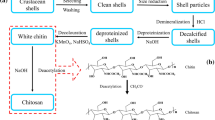Abstract
The present work was aimed at developing stability enhanced silica gel-supported macroporous chitosan membrane for immobilization of enzymes. The membrane was surface modified using various cross-linking agents for covalent immobilization of enzyme Bovine serum albumin. The results of FT-IR, UV–vis, and SEM analyses revealed the effect of cross-linking agents and confirmed the formation of modified membranes. The presence of silica gel as a support could provide a large surface area, and therefore, the enzyme could be immobilized only on the surface, and thus minimized the diffusion limitation problem. The resultant enzyme immobilized membranes were also characterized based on their activity retention, immobilization efficiency, and stability aspects. The immobilization process increased the activity of immobilized enzyme even higher than that of total (actual) activity of native enzyme. Thus, the obtained macroporous chitosan membranes in this study could act as a versatile host for various guest molecules.






Similar content being viewed by others
References
Anjali Devi D, Smitha B, Sridhar S, Aminabhavi TM (2005) Pervaporation separation of isopropanol/water mixtures through crosslinked chitosan membranes. J Membr Sci 262:91–99
Asaeda M, Ishida M, Waki T (2005) Pervaporation of aqueous organic acid solutions by porous ceramic membranes. J Chem Eng Jpn 38:336–343
Bautista FM, Bravo MC, Campelo JM, Garcia A, Luna D, Marinas JM, Romero AA (1999) Covalent immobilization of acid phosphatase on amorphous AlPO4 support. J Mol Catal B 6:473–481
Beppu MM, Santana CC (2001) In vitro biomineralization of chitosan. Key Eng Mater 31:192–195
Beppu MM, Arruda EJ, Vieira RS, Santos NN (2004) Adsorption of Cu(II) on porous chitosan membranes functionalized with histidine. J Membr Sci 240:227–235
Beppu MM, Vieira RS, Aimoli CG, Santana CC (2007) Crosslinking of chitosan membranes using glutaraldehyde: effect on ion permeability and water absorption. J Membr Sci 301:126–130
Desai K, Kit K, Li J, Zivanovic S (2008) Morphological and surface properties of electrospun chitosan nanofibers. Biomacromolecules 9:1000–1006
Ge J, Cui Y, Yan Y, Jiang W (2000) The effect of structure of pervaporation of chitosan membrane. J Membr Sci 165:75–81
Hong P-Z, Li S-D, Ou C-Y, Li C-P, Yang L, Zhang C-H (2007) Thermogravimetric analysis of chitosan. J Appl Polym Sci 105:547–551
Iwata H, Saito K, Furusaki S (1991) Adsorption characteristics of an immobilized metal affinity membrane. Biotechnol Prog 7:412–418
Kawai T, Saito K, Lee W (2003) Protein binding to polymer brush, based on ion-exchange, hydrophobic, and affinity interactions. J Chromatogr B 790:131–142
Kuraoka K, Kubo N, Yazawa T (2000) Microporous silica xerogel membrane with high selectivity. J Sol-Gel Sci Technol 19:515–518
Manjubala I, Scheler S, Bössert J, Jandt KD (2006) Mineralisation of chitosan scaffolds with nano-apatite formation by double diffusion technique. Acta Biomater 2:75–84
Nisnevitch M, Firer MA (2001) The solid phase in affinity chromatography: strategies for antibody attachment. J Biochem Biophys Methods 49:467–480
Oh J-T, Kim J-H (2000) Preparation and properties of immobilized amyloglucosidase on nonporous PS/PNaSS microspheres. Enzyme Microb Technol 27:356–361
Okuyama K, Noguchi K, Miyazawa T, Yui T, Ogawa K (1997) Molecular and crystal structure of hydrated chitosan. Macromolecules 30:5849–5855
Plueddmann EP (1991) Silane coupling agents. Plenum, New York
Shentu J, Wu J, Song W, Jia Z (2005) Chitosan microspheres as immobilized dye affinity support for catalase adsorption. Int J Biol Macromol 37:42–46
Singh DK, Ray AR (1998) Characterization of grafted chitosan films. Carbohyd Polym 36:251–255
Suen SY, Lin SY, Chin HC (2000) Effects of spaces arms on Cibacron Blue 3GA immobilization and lysozyme adsorption using regenerated cellulose membrane discs. Ind Eng Chem Res 39:478–487
Uragami T, Matsuda T, Okuno H, Miyata T (1994) Structure of chemically modified chitosan membranes and their characteristics of permeation and separation of aqueous ethanol solutions. J Membr Sci 88:243–251
Wang XP, Shen ZQ, Zhang FY (1998) Pervaporation separation of water alcohol mixtures through hydroxypropylated chitosan membranes. J Appl Polym Sci 69:2035–2041
Wei YC, Hudson SM, Mayer JM, Kaplan DL (1992) The crosslinking of chitosan fibers. J Polym Sci 30:2187–2193
Zakaria Z, Izzah Z, Jawaid M, Hassan A (2012) Effect of degree of deacetylation of chitosan on thermal stability and compatibility of chitosan-polyamide blend. Bioresources 7:5568–5580
Zeng X, Ruckenstein E (1996a) Supported chitosan-dye affinity membranes and their protein adsorption. J Membr Sci 117:271–278
Zeng X, Ruckenstein E (1996b) Control of pore sizes in macroporous chitosan and chitin membranes. Ind Eng Chem Res 35:4169–4175
Zeng X, Ruckenstein E (1998) Cross-linked macroporous chitosan anion-exchange membranes for protein separations. J Membr Sci 148:195–205
Acknowledgments
We thank the National Central University and National Science Council (NSC, (Grant No.: NSC100-2923-E-008-001-MY3), Taiwan, Republic of China (ROC) and Department of Science and Technology (DST, Ref no/S/FST/ESI-101/2010), New Delhi, India, for financial support.
Author information
Authors and Affiliations
Corresponding author
Electronic supplementary material
Below is the link to the electronic supplementary material.
Rights and permissions
About this article
Cite this article
Yang, WY., Thirumavalavan, M., Malini, M. et al. Development of Silica Gel-Supported Modified Macroporous Chitosan Membranes for Enzyme Immobilization and Their Characterization Analyses. J Membrane Biol 247, 549–559 (2014). https://doi.org/10.1007/s00232-014-9671-y
Received:
Accepted:
Published:
Issue Date:
DOI: https://doi.org/10.1007/s00232-014-9671-y




